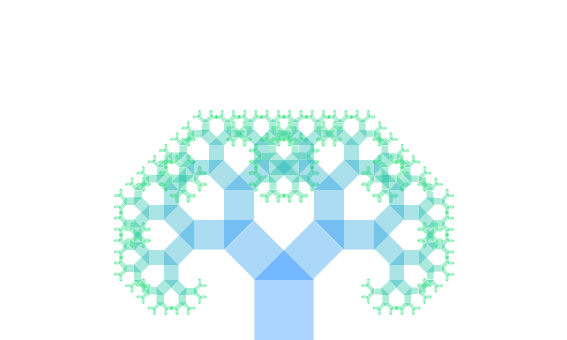En Febrero recién pasado tuve el honor de formar parte del primer programa de maestría en diseño de interacción, en Costa Rica. En esa ocación tuve el placer de colarme en el curso de Tomás de Camino a de introducción a la programación. Acá les dejo uno de los primeros ejercicios del curso:
show code
/*
* Recursive Hypotenuse
* by Herbert Spencer
* February 2014
*/
float ang; // this is the global angle
int levels; // this is the amount of tree levels or how many times we will call the recursive function
void setup() {
size(510, 510);
noStroke();
smooth();
levels = 3; // start with something small
mouseX = width/2; // place the mouse in the middle
}
void draw() {
// white background
background(255);
// the global angle can be modified by de 'x' movement of the mouse
ang = map(mouseX, 0, width, -HALF_PI, 0);
// this is where we call the recursive function
hypotenuse(width/2 - 30, height, width/2 + 30, height, levels);
}
// this is the recursive function
// it requeres 4 floats and 1 int. The floats represent the position of 2 points, which define the hypotenuse
// the level defines how many times are we calling this function recursevely
void hypotenuse(float x1, float y1, float x2, float y2, int level) {
// determine the length, which is the distance between the points. We'll call it 'side', the side of the square
float side = dist(x1, y1, x2, y2);
// determine the angle between the two points... not so tricky
float t = atan2(y2- y1, x2 - x1);
// reset the coordinate system, just to be polite
pushMatrix();
{
// translate our axis to the first point, our new (0,0)
translate(x1, y1);
// align space to the hypothenuse, using the angle we've just calculated
rotate(t);
// draw the square
fill(col(level), 90); // nice color with transparency
rect(0, -side, side, side);
// translate to the new hypothenuse
translate(0, -side);
// determine the lengths of the triangle sides given a global angle 'ang'.
// 'a, b, c'; where 'c' is the hypotenuse. We have 'c', it's the distance between the first two points, ok?
float a = cos(ang) * side;
float b = sin(ang) * side;
// draw the triangle
noStroke();
fill(col(level), 150);
beginShape();
{
vertex(0, 0); // first vertex
vertex(cos(ang) * a, sin(ang) * a); // tricky second vertex
vertex(side, 0); // third vertex
}
endShape();
// this is a method to eventually escape from this recursive fuction
if (level > 0) {
hypotenuse(0, 0, cos(ang) * a, sin(ang) * a, level-1);
hypotenuse(cos(ang) * a, sin(ang) * a, side, 0, level-1);
}
}
popMatrix();
}
void keyPressed() {
// you can toggle the levels by hitting keys a-z
if (key == 'a') {
levels++;
}
if (key == 'z') {
levels--;
}
// so we keep levels reasonable...
levels = constrain(levels, 0, 16);
// output to console how many levels do we have at the moment
println("levels = "+levels);
}
color col(int level){
int n = levels - level;
float r = 18;
float g = 134 + 11 * n;
float b = 255 - 19 * n;
color c = color(r,g,b);
return c;
}
Para agregar o quitar niveles de recursión debes presionar las teclas a y z. El código está publicado acá.

Agregar un comentario